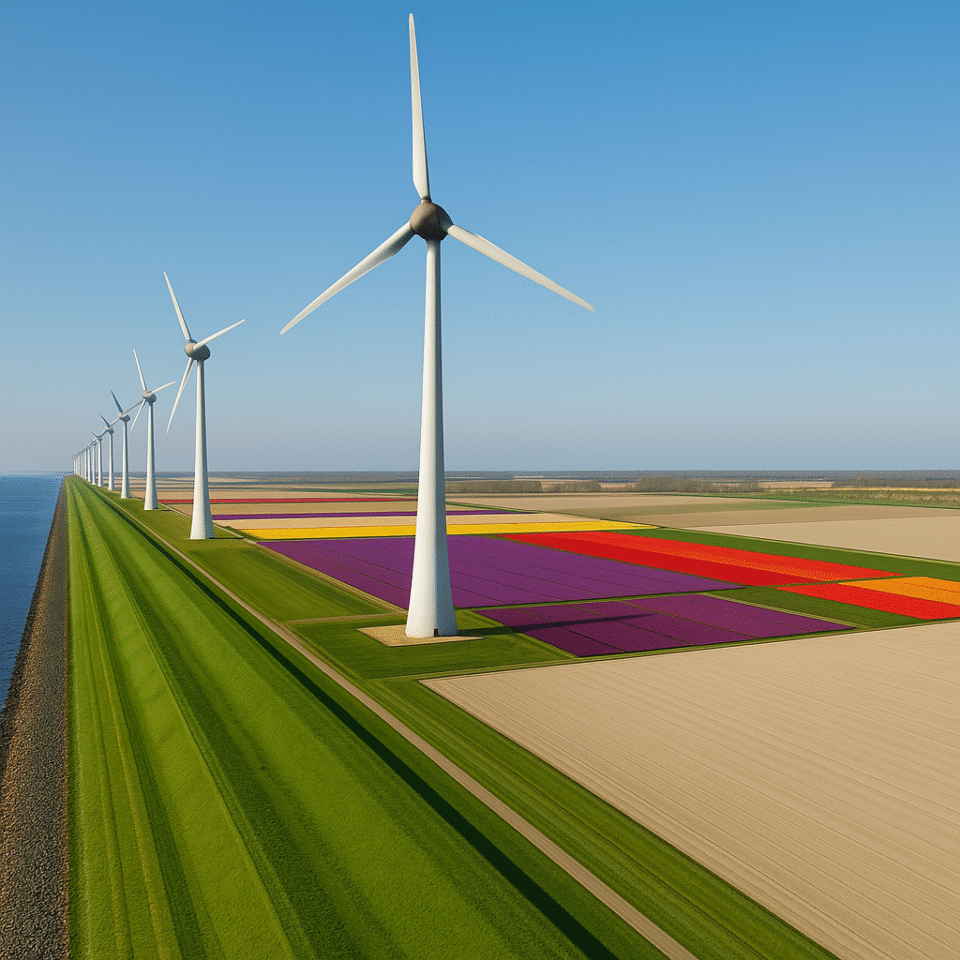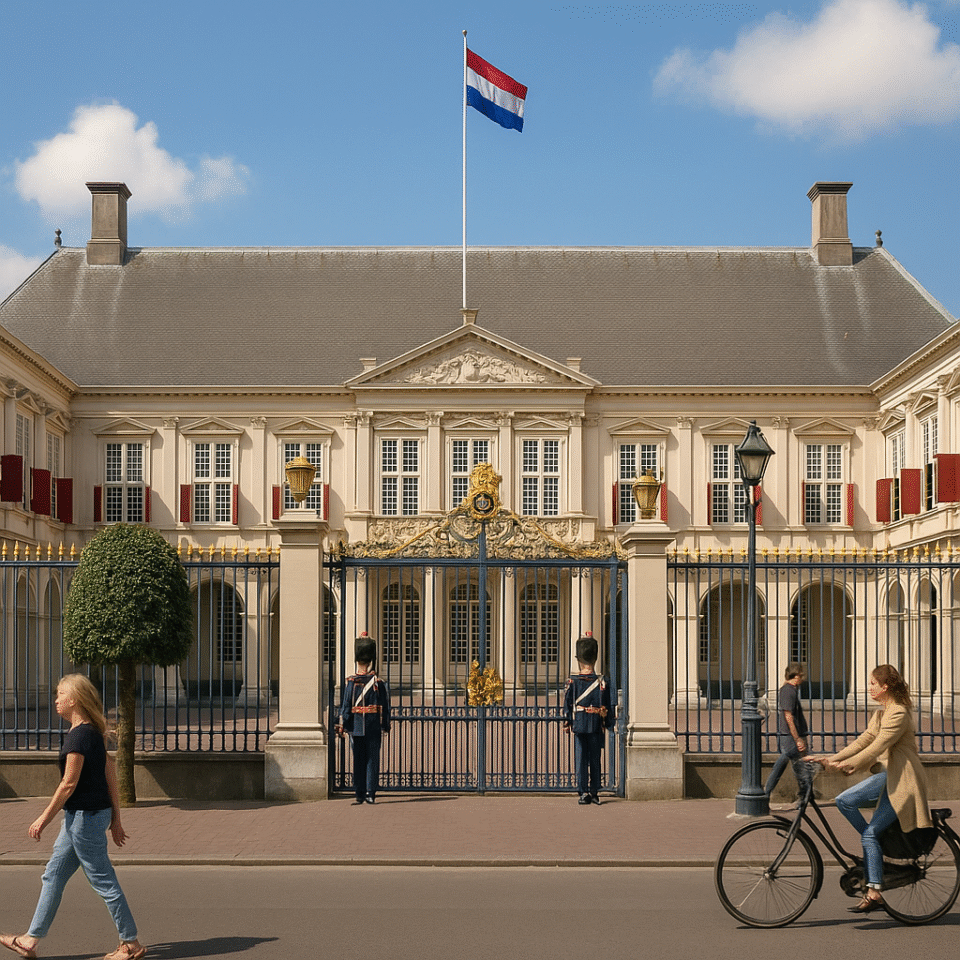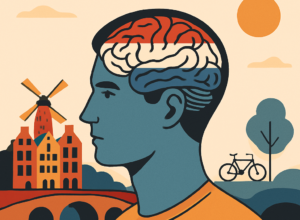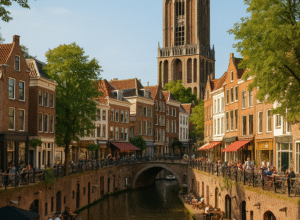The Netherlands’ Youngest Province Where Engineering Meets Nature
In a country famous for battling the sea, no place embodies Dutch ingenuity quite like Flevoland, an entire province that didn’t exist a century ago, now home to nearly half a million people on land reclaimed from the bottom of the sea.
Stand anywhere in Flevoland and you’re witnessing one of humanity’s most ambitious engineering projects. This entire province (every road, every building, every tree) sits on land that was underwater until the mid-20th century. For Americans accustomed to states that have existed for centuries, Flevoland presents something challenging to grasp: a completely planned landscape, designed and built from scratch in living memory.
As the Netherlands’ twelfth and youngest province, officially established in 1986, Flevoland represents the culmination of the Dutch battle against water. With approximately 430,000 residents spread across 2,412 square kilometers, it’s neither the largest nor most populous Dutch province, but it’s certainly the most remarkable in terms of human achievement. Here, modern cities rise from perfectly flat landscapes, nature reserves teem with wildlife that colonized virgin territory, and every vista tells the story of what happens when human determination meets careful planning.

A Province Born from Ambition
The Zuiderzee Works: Engineering Marvel
Flevoland’s story begins with the Zuiderzee Works (Zuiderzeewerken), one of the most ambitious hydraulic engineering projects ever undertaken. What Americans might compare to the construction of the Panama Canal or Hoover Dam, the Dutch accomplished on an even grander scale – creating an entire province from what was once the bottom of the sea.
The process began in 1932 with the completion of the Afsluitdijk, a 32-kilometer dam that sealed off the Zuiderzee from the North Sea, creating the freshwater IJsselmeer. Over the following decades, engineers systematically drained sections of this inland sea, creating polders (areas of reclaimed land protected by dikes). The Eastern Flevoland polder was completed in 1957, followed by Southern Flevoland in 1968, creating the landmass that would become the province.
For perspective, imagine if Americans had drained Lake Erie and built cities where Buffalo once required boats to reach Rochester. The scale becomes almost incomprehensible when you realize that Flevoland encompasses 1,419 square kilometers of reclaimed land, roughly the size of Los Angeles, created entirely through human intervention.
Provincial Status and Modern Development
Unlike other Dutch provinces with medieval origins, Flevoland’s political development happened in fast-forward. Initially administered as part of neighboring provinces, the growing population and unique character of the reclaimed lands led to the establishment of Flevoland as an independent province in 1986. This makes it younger than many American shopping malls, yet it functions as a full-fledged province with its own government, identity, and culture.
The province’s rapid development created unique opportunities for urban planning that simply don’t exist elsewhere in the densely populated Netherlands. Cities like Almere and Lelystad were designed from the ground up, incorporating modern principles of sustainability, green space integration, and efficient transportation – concepts that older Dutch cities had to retrofit over centuries.
Urban Planning on a Blank Canvas
Almere: A New City Success Story
Almere stands as perhaps the most successful example of planned city development in Europe. Started in 1976 on completely empty land, it has grown to become the Netherlands’ eighth-largest city with over 220,000 residents. For Americans familiar with planned communities like Columbia, Maryland, or The Woodlands, Texas, Almere represents this concept scaled up to city size.
The city’s design emphasizes sustainability and quality of life in ways that would be impossible to achieve in established urban areas. Wide cycling paths connect distinct neighborhoods, each with its own character and amenities. Extensive green spaces weave throughout the urban fabric, and the city center features modern architecture that prioritizes pedestrians and cyclists over automobiles.
What makes Almere particularly interesting for American visitors is how it challenges assumptions about urban development. Rather than growing organically around historical cores, Almere was planned to prevent urban sprawl, maintain green corridors, and create efficient public transportation networks from day one. The result is a city that feels both thoroughly modern and surprisingly livable.
Lelystad: The Provincial Capital
Named after Cornelis Lely, the engineer who conceived the Zuiderzee Works, Lelystad serves as Flevoland’s capital and showcases different aspects of planned development. With approximately 80,000 residents, it maintains a more intimate scale than Almere while offering excellent access to both urban amenities and natural areas.
Lelystad’s airport primarily serves general aviation and cargo, with long-delayed plans for commercial passenger service still pending. The city also houses Batavia Stad Fashion Outlet, one of Europe’s largest outlet shopping centers, which draws visitors from across the Netherlands and neighboring countries.
Other Settlements: Planned Communities
Flevoland’s other municipalities each represent different approaches to community development:
- Dronten: Agricultural center (population ~42,000) that demonstrates how modern farming integrates with planned communities
- Zeewolde: Smaller town (~23,000) emphasizing green living and sustainable development
- Urk: The fascinating exception – a former island community that predates the land reclamation and maintains its distinct fishing village character
Nature Reclaims Reclaimed Land
Oostvaardersplassen: Europe’s Serengeti
Perhaps nowhere in Flevoland demonstrates the province’s remarkable character better than Oostvaardersplassen Nature Reserve. This 56-square-kilometer reserve, established on land that was underwater until 1968, has become one of Europe’s most important wetland ecosystems and a fascinating experiment in “rewilding.”
The reserve’s approach differs dramatically from traditional European nature management. Instead of maintaining carefully manicured landscapes, Oostvaardersplassen allows large herbivores (including Konik horses, Heck cattle, and red deer) to shape the environment naturally. For American visitors familiar with Yellowstone or other wilderness areas, this represents a European attempt to recreate similar ecological processes on a much smaller but equally significant scale.
The results have been remarkable. What began as empty farmland has developed into crucial habitat for migratory birds, with over 300 bird species recorded in the area. The reserve now serves as an important stopover point for birds traveling between Arctic breeding grounds and African wintering areas.
Marker Wadden: Engineering Meets Ecology
Flevoland’s newest addition, the Marker Wadden archipelago, represents the next evolution in Dutch water management and ecological restoration. These artificial islands, constructed in the Markermeer between 2016 and ongoing, use innovative techniques to create habitat while improving water quality.
The project demonstrates how contemporary Dutch engineering integrates environmental restoration with water management. Unlike the original land reclamation projects focused purely on creating usable land, Marker Wadden prioritizes ecological benefits while showcasing new approaches to working with water rather than simply controlling it.
Agricultural Innovation and Food Production
Modern Farming in a Planned Landscape
Flevoland’s agricultural sector benefits enormously from starting with a blank slate. The province’s farms were designed from the beginning to incorporate modern efficiency, optimal field sizes, and integrated water management. This planning advantage has made Flevoland one of the Netherlands’ most productive agricultural regions despite its recent creation.
The province produces significant quantities of potatoes, sugar beets, wheat, and other grains. More interesting for American visitors might be the province’s role in sustainable agriculture innovation. Many farms here serve as testing grounds for precision agriculture, sustainable farming techniques, and integrated pest management – approaches that balance productivity with environmental responsibility.
Agribusiness and Food Technology
The province’s planned development attracted food processing and agricultural technology companies that benefit from modern infrastructure and proximity to both production areas and transportation networks. This concentration has made Flevoland an important center for agricultural innovation in the Netherlands.
Transportation and Accessibility
Connecting to the Netherlands
Despite its recent creation, Flevoland enjoys excellent transportation connections to the rest of the Netherlands. The A6 and A27 highways provide direct links to Amsterdam and Utrecht, while the province’s flat terrain and modern planning make it exceptionally bicycle-friendly.
Train service connects major Flevoland cities to the national rail network, though frequencies can be lower than in the Randstad region. For American visitors, this demonstrates how even newly developed areas in the Netherlands prioritize public transportation and cycling infrastructure over automobile dependence.
Internal Transportation
Within Flevoland, the planned nature of development creates advantages for getting around. Cities feature logical layouts, extensive cycling networks, and efficient public transportation. The flat terrain makes cycling particularly pleasant, and the wide open landscapes offer scenic routes that would be impossible in more densely developed provinces.
Living in Flevoland: Modern Life in a New Land
For American Residents: From DAFT Entrepreneurs to Families
Flevoland presents a compelling proposition for Americans considering life in the Netherlands, though with different advantages depending on your situation and goals.
For DAFT entrepreneurs, Flevoland offers a strategic combination of affordability, space, and connectivity. Cities like Almere provide excellent rail links to Amsterdam (under 30 minutes), making them surprisingly viable for remote workers, consultants, and creative professionals who need occasional access to major business centers. The cost savings on housing and office space can be substantial, and Almere increasingly features co-working spaces, startup incubators, and bilingual services aimed at international residents.
For families and other American expats, the province’s modern amenities, spacious housing, and excellent access to both urban conveniences and natural areas create an appealing quality of life. The planned cities offer safe neighborhoods, excellent schools, and abundant green space that’s harder to find in the densely populated Randstad.
The trade-offs are real, however. Flevoland’s newness means fewer established expat communities and potentially greater language barriers outside the largest cities. English-language services and international social groups are less common than in Amsterdam or The Hague, requiring more intentional effort to build social connections. If you’re the type of American who values quiet, space, and modern comforts over nightlife and expat-heavy neighborhoods, Flevoland might be your ideal base. If you need constant international networking or prefer ready-made expat communities, you might find it isolating.
Quality of Life Considerations
The planned nature of Flevoland’s development creates several quality-of-life advantages. Cities feature abundant green space, efficient layouts, and modern infrastructure. Air quality tends to be better than in older, more industrial areas, and the province’s emphasis on sustainability attracts residents interested in environmental responsibility.
For families, Flevoland offers excellent schools, safe neighborhoods, and easy access to outdoor recreation. The province’s youth means that many facilities and systems incorporate contemporary best practices in education, healthcare, and community services.
Cultural Development in a New Province
Creating Identity from Scratch
Unlike provinces with centuries of distinct cultural traditions, Flevoland faces the unique challenge of creating provincial identity and culture within living memory. This process offers fascinating insights into how communities develop shared traditions and collective identity.
The province has embraced its engineering heritage and modern character rather than attempting to manufacture historical traditions. Cultural events often celebrate innovation, sustainability, and the remarkable achievement of creating land from water. This approach creates a distinctly contemporary cultural identity that reflects the province’s unique origins.
Architecture and Design
Flevoland’s architecture reflects its era of development, featuring modernist and contemporary designs that would be impossible to achieve in historically protected city centers elsewhere in the Netherlands. This creates opportunities for innovative architecture and urban design that attract visitors interested in contemporary Dutch planning and design achievements.
The province serves as something of a showcase for sustainable building practices, energy-efficient design, and integration of green spaces with urban development. For Americans interested in urban planning and sustainable development, Flevoland offers compelling examples of how these principles can be implemented at scale.
Seasonal Experiences and Tourism
What to See and Do
Flevoland’s attractions reflect its unique character and recent development:
- Batavia Stad Fashion Outlet: Major shopping destination with international brands
- Walibi Holland: Large amusement park offering entertainment for families
- Oostvaardersplassen: World-class nature reserve and bird-watching destination
- Lelystad Airport: Aviation museum and historic aircraft displays
- Almere Stad: Modern city center showcasing contemporary Dutch urban design
Natural Attractions by Season
The Oostvaardersplassen reserve offers different experiences throughout the year. Spring brings migratory bird arrivals and active wildlife behavior. Summer provides optimal conditions for hiking and wildlife observation. Autumn offers spectacular bird migration displays, while winter can provide unique opportunities to observe how large herbivores adapt to seasonal changes.
For American visitors accustomed to national parks with varied terrain, Flevoland’s flat landscapes might initially seem monotonous. However, the subtle variations in water levels, vegetation, and wildlife create surprisingly diverse experiences for those willing to observe carefully.
Economic Landscape and Innovation
Modern Economic Development
Flevoland’s economy reflects its planned development and modern origins. Key sectors include:
- Agriculture and food processing
- Logistics and distribution (benefiting from central location and modern infrastructure)
- Renewable energy (particularly wind power)
- Tourism and recreation
- Technology and innovation companies
The province has actively courted sustainable businesses and companies focused on environmental technology, creating a economic profile that aligns with its modern, environmentally conscious identity.
Future Development
Flevoland continues to evolve, with ongoing projects in sustainable energy, ecological restoration, and innovative urban development. The province serves as a testing ground for approaches that may influence future development throughout the Netherlands and beyond.
A Province That Defies Expectations
Flevoland challenges many assumptions about what a place should be. It’s neither ancient nor traditional, neither naturally formed nor historically significant in conventional terms. Instead, it represents something entirely different: proof that humans can create not just buildings or cities, but entire landscapes and the communities that inhabit them.
For American visitors, Flevoland offers experiences unavailable anywhere else in the world. You can walk on land that was sea bottom within living memory, visit cities planned and built from nothing within a single generation, and observe ecosystems developing in real-time on virgin territory. It’s a place where the ambition of human engineering meets the resilience of natural systems, creating something entirely new.
Whether you’re interested in cutting-edge urban planning, remarkable engineering achievements, innovative approaches to conservation, or simply experiencing what happens when humans get the chance to start completely fresh, Flevoland rewards visitors with insights into both human capability and nature’s adaptability. In a world where most places are defined by their history, Flevoland stands as testament to what’s possible when vision, engineering, and determination combine to literally create new ground.
Metadata (for Rank Math and WordPress)
Slug:








